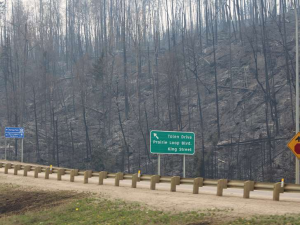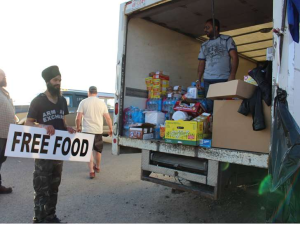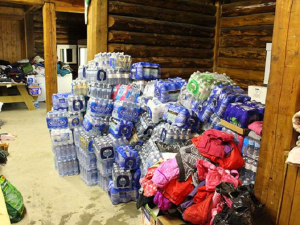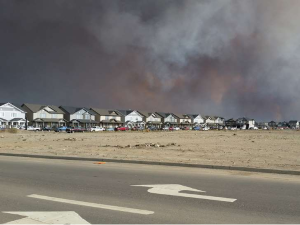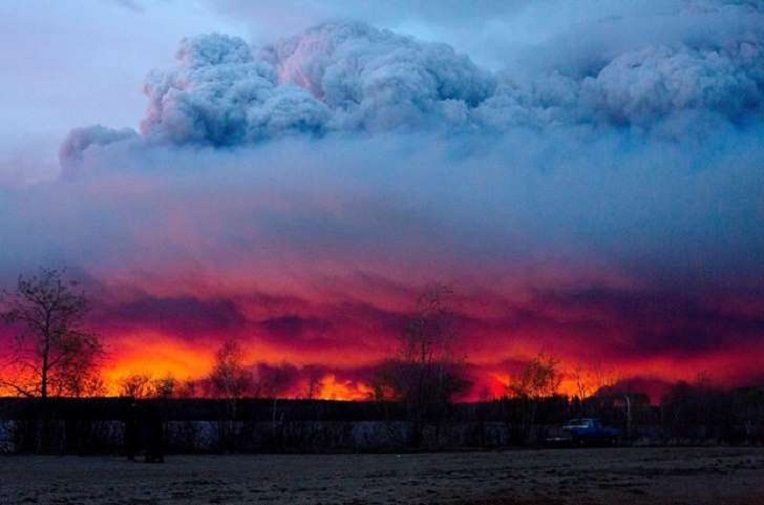
There’s a reason that sleep-deprived woodland firefighters begin to see forest fires as a sentient, intelligent foe. The Fort McMurray fire is moving underground. It is smoldering in peaty forest floors for days, only to explode to the surface like a hand grenade. It will sweep along a wide front, or fan out into unpredictable guerilla assaults. It has demolished people’s home, but left their car unscathed just to prove that it can. The fire has burned through the rear fences of homes, only to fizzle out a few metres from the back door like some kind of sick “I’ll be back” threat. But all things considered, Fort McMurray emerged from a biblical firestorm in relatively good shape. “The geese are coming back; at least something’s normal around here,” said Wood Buffalo councillor Phil Meagher, gesturing to a flight of squawking Canada geese migrating unseen above the smoke. Still dressed in the gym clothes he threw on at the time of Tuesday’s hectic evacuation, he’s joined the growing chorus of Fort McMurrayites who are somewhat miffed at the disaster images being played endlessly on televised news reports. About 80 per cent of the city is unscathed, and the luckiest outcome was that the fire did not penetrate forested recreational areas in the city’s core. Piled high with decades of forest debris, it would have burned like a Presto log. The downtown is fine. The hospitals survived. The Beacon Hill neighbourhood was hit the hardest, but even there the schools escaped relatively unscathed. The cemetery was spared. “Nobody’s mentioning that; the dead people are fine,” said Meagher. Fort McMurray, now ringed by a smoking hinterland of scorched earth, remains roped off to all but essential services — and may remain so for weeks to come. There are “consequences” for anybody peeling off from an evacuation convoy, and all non-uniformed persons found on the streets of Alberta’s sixth largest city are immediately arrested. Indeed, this has already happened to at least two unauthorized pet rescuers spotted busting down the doors of desperate evacuees to free trapped cats. The only reason the National Post was able to get in was by joining a five-vehicle private relief convoy bringing supplies to the north. On Friday night, while driving through the fire zone it navigated about 100 kilometres of highway so choked with smoke that visibility was down to about 20 meters. It stings the eyes and, after a few minutes, induces nausea. Every smoke alarm in Fort McMurray has been ringing for days, and every curtain, awning and cushion in the city will be radiating the smell of campfire for months. The streetlights are still coming on, and in the smoke they gave the empty city an eerie glow. Light also emanates from the occasional house or apartment building where a lamp was left on in the chaos of the evacuation. And along the roads, meanwhile, there was a still a haphazard Walking Dead-style collection of vehicles parked at crazy angles and abandoned at the exact points where they ran out of gas. “Mother Nature has a way of putting you back in your place real fast,” said convoy leader Barry Cherneske. By Saturday, the vast majority of evacuees were either in Edmonton or scattered to family and friends across Canada. Tellingly, as far away as the Atlantic Coast the ferry company Marine Atlantic was offering free passage to any Fort McMurray evacuee trying to get their car to Newfoundland. The Shell-owned Albian Aerodrome, in particular, had sprung into action within hours to mount a staggering private airlift of evacuees trapped in the north. The airport is normally used exclusively for 737 flights ferrying workers into the oil sands, but for several days it coordinated military and charter aircraft evacuating more than 7,000 people. For several days, Shell’s famously tight security was set aside, and fleet of buses were dispatched into oil sands camps, where sheltering evacuees would be rounded up and dispatched into either a packed airliner or into the cargo hold of a C-130 Hercules. As with all Alberta disasters, the overarching theme of the Fort McMurray fire has been the intense, single-minded drive of Albertans to help in any way possible. Most Canadians will fill sandbags or shelter their neighbours in times of disaster, of course, but in the prairies responding to tragedy is an obsession. Last summer, for instance, Edmonton Police Constable Daniel Woodall was fatally shot while serving an arrest warrant. Police deaths are always appropriately mourned in other major Canadian cities, of course, but in Edmonton it was a miniature 9/11. Within a day, virtually every light standard in the city was adorned with blue ribbons and Edmonton Police were barraged with letters, crafts and gifts of food. It’s this spirit that Premier Rachel Notley and other officials have been referencing for the past week when they talk about “Albertans helping Albertans.” “That’s what Albertans do when people are in need,” she said. People are getting “Alberta Strong” tattoos. Thousands are emblazoning their trucks with “Fort Mac Supporter” decals. On Saturday, at the southern roadblock into Fort McMurray sat a line of about eight horse trailers manned by volunteers prepared to wait for days until officials would let them in to evacuate Fort McMurray’s stranded horses. In Edmonton, virtually anybody with a hint of wood smoke on them were given free meals, free oil changes, free haircuts, free pet grooming and fistfuls of cash from random bystanders. When news got around that a Wal-Mart was hassling donation drives held in its parking lots, the store was boycotted and barraged with social media outrage until it quickly apologized and acquiesced. Thousands offered up guest rooms or entire houses rendered vacant by the economic downturn. At the website YMMFire.ca, 42,000 households registered to host an evacuee. A Days Inn crammed with evacuees put out an alert on social media for diapers and soap, and within three hours it was turning away donors due to lack of space. On social media, at least one evacuee still shaken by the fire said she was nervous to go to a supply centre because she wasn’t emotionally prepared to deal with the overwhelming number of offers for assistance. “I know there are several events available for us to take advantage of today, but I honestly just want to go to bed and this nightmare be over,” she wrote. In the increasingly empty areas around Fort McMurray, the crush of supplies was becoming overwhelming. The landscape was strewn with minivan-sized piles of bottled water, and there were reports of Albertans loading up their pickup trucks with just a few jerry cans and bags of dog food and driving five hours into areas long cleared of evacuees.
Scorched earth at the side of Highway 63 as it runs through Fort McMurray.
All along the highway south from Fort McMurray were dozens of volunteers sitting in lawn chairs next to pickup trucks full of gas cans and water, banking on the possibility that a passing motorist was parched or needed a top-up of gas. Some highway pullouts featured multiple such trucks competing for evacuee attention. In the early stages of the disaster, these impromptu rescuers had been a godsend to thousands of out-of-gas Fort McMurrayites who were faced with the prospect of spending a night along Highway 63 in a car packed with cats and babies. But for the evacuees still trickling down, most have been well-fuelled and well-supplied by oil sands camps and military airlifts. And after hours of waiting on Fort McMurray’s north side for a police escort through the fire zone, they’re usually making a beeline to accommodations around Edmonton.
A group from Edmonton provides free roadside food to evacuees at Grassland, AB on Friday, May7.
Since Friday, Alberta emergency officials have gotten get in front of a microphone, they have asked Albertans to either donate to the Red Cross or to assist at the Edmonton-area evacuation centres now servicing the bulk of evacuees. “The most effective thing people can do right now is make donations to the Red Cross,” Notley said last week. Regardless, the convoys into Fort McMurray and environs continued. On Sunday, Facebook still abounded with triumphal “on our way!” posts of diaper-laden trucks headed north emblazoned with “Alberta Proud” scrawled across the back window. These same Facebook pages, meanwhile, also abounded with evacuation centres begging people to stop overwhelming them with supplies. “The community of Conklin thanks everyone for the donation of supplies for evacuees, we are now overwhelmed with supplies and ask they be directed to other centres in need,” read one. My own convoy headed north with five vehicles carrying as much as $20,000 in supplies, including at least $12,000 in over-the-counter medications provided at deep discount by Rexall.
A pile of donated bottled water at Kikino Silver Birch Resort, which is hosting an estimated 500 evacuees.
The destination was Fort McKay First Nation, a community just north of Fort McMurray that was one of the few in the area still requesting donations. Having hosted more than 1000 evacuees, it was reportedly in desperate need of resupply. Under the best of times, the drive would take more than six hours. But our journey would include a midnight police escort through areas within meters of active burns. Once on the other side, meanwhile, shifting fire conditions could leave the convoy stranded for days. “Run the red lights; I won’t tell you to do that after today,” said an RCMP officer manning the southern roadblock into Fort McMurray. Nearby, an advancing fire line cast a threatening orange glow. As was the case with other private convoys, our procession was showered with support as it headed north. An envelope of $50 bills here, a free case of Girl Guide cookies at a gas station there. Supportive honks from passing police and firefighting vehicles. Free cardboard boxes from a moving company. Free accommodation for team members at an oil sands camp. Thousand dollar grocery tabs picked up spontaneously by random donors; a pretty hefty sacrifice given Alberta’s economy lately. But by the time we arrived, Fort McKay had been totally cleared of evacuees, and an evacuation of the 400-person reserve was already underway. The community may have been crawling with evacuees that morning, but within a few hours it would be empty. And as the cringing face of the community’s doctor quickly belied, far from being desperate for supplies Fort McKay had been utterly inundated with shipments. A nearby Brion Energy camp had been sending daily loads of perishables. And we had barely arrived before a cargo van pulled up loaded with pallets from a military airlift. As we left a few minutes later, another larger truckload was seen arriving.
The personal toll of this Edmonton to Fort McKay convoy had been enormous. Team members had left jobs, spouses and stables of horses with only a few hours notice. And now, after delving head-first into the enormous logistics of disaster supply, they were navigating Northern Alberta highways after having gone four days without sleep — and subsisting on a diet of donuts, stress, cigarettes and energy drinks. On Friday night, nerves began to fray, emotions boiled and several disenchanted members even left to head back to Edmonton. But the majority stayed, got two hours sleep, and continued — even pausing for three hours at the side of Highway 63, although only a handful of evacuees turned up to request anything. Ultimately, after another 10-hour odyssey to get back south of Fort McMurray, most of the convoy’s supplies were simply added to the teetering piles of water, toiletries and dog food in the hamlet of Wandering River, one of the only communities in the north that still had space. The camp had buzzed with 600 workers before the fire, but has now been reduced to less than 40 in anticipation… By any empirical measure, this particular expedition had been a kind of Charge of the Light Brigade; a heroic and taxing journey of dubious utility. But the members were undaunted, by Saturday afternoon they were organizing a massive shipment of medical supplies to firefighters, and by Sunday were back to marshalling an ever-expanding network of drivers and supplies dropped off at the North Edmonton garage acting as their muster point. Among the more pragmatic Fort McMurray evacuees waiting their turn on Saturday for an escort south, there was a sentiment that, in the worst way possible, a lot of the city’s recent economic troubles have just been solved. Oil prices are up. Reconstruction work will bring jobs back to the city. The freefall in housing prices has been stemmed by the simple fact that there aren’t as many houses anymore. Even local hotels have seen share prices jump. But for now, it’s little comfort to the people nursing 1000-mile stares at evacuee centres throughout Alberta.
Photo out of Fort McMurray taken during the evacuation. The smoke clouds hanging over the city had been small wisps of smoke on the horizon only 25 minutes previously.
Forest fire evacuations are usually orderly affairs. The air quality drops below a certain point, and community members are calmly asked to pack their bags and clear out as a precaution. But as the carved-up highway medians around Fort McMurray attest, this was a city of people fleeing for their lives. At points along Highway 63, the gap between tree lines can be as much as 100 metres apart. In Tuesday’s high winds, fire breaks like these had been little more than a speed bump. Paul, an oil sands worker who joined our rescue convoy, had been among those fleeing south. He’d been stuck in slow moving traffic as flames coursed overtop his car, and his passengers leaned away from the windows to get away from the heat. It is a common frustration among emergency workers that homeowners in the path of a forest fire will refuse to evacuate because they believe they can fend off the approaching flames with a few sprinklers and a garden hose. Nobody in Fort McMurray believes that anymore.

